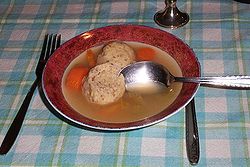
Back Boles de matsà Catalan Matzahboller Danish Matzeknödel German Bolas de matzah Spanish ماتزو بال Persian Kneidleh French קניידלך HE Bakso matzah ID Matsebal Dutch Kneidl Portuguese
 | |
| Alternative names | Kneieydl, knaidel or kneidel in singular. Kneydlech, knaidelech or kneidelech, or knaidlach in plural.[1] |
|---|---|
| Type | Dumpling |
| Region or state | Ashkenazi Jewish areas of Central and Eastern Europe, with extensive history and cultural significance in Ukraine, Bulgaria, Romania, Turkey, Israel and the Jewish diaspora[2][3][4] |
| Serving temperature | Temperature at which broth simmers[5][6] |
| Main ingredients | Matzah meal, egg, water, oil or schmaltz or margarine[5][6] |
Matzah balls or matzo balls are Ashkenazi Jewish soup morsels made from a mixture of matzah meal, beaten eggs, water, and a fat, such as oil, margarine, or chicken fat. Known as knaidel in Yiddish (Yiddish: קניידלעך kneydlekh pl., singular קניידל kneydl; with numerous other transliterations), they resemble a matzah meal version of knödel, bread dumplings popular throughout Central European and East European cuisine.[7][8][9]
Matzah balls are traditionally served in chicken soup and are a staple food on the Jewish holiday of Passover, though they are not eaten during Passover by those who observe a prohibition on soaking matzah products.
The texture of matzah balls may be light or dense, depending on the recipe. Matzah balls made from some recipes float in soup; others sink.[10]
- ^ Cite error: The named reference
NYTwas invoked but never defined (see the help page). - ^ Nathan, Joan (2011). Joan Nathan's Jewish Holiday Cookbook. Random House. p. 12. ISBN 9780307777850.
- ^ Durham, Michael (2009). National Geographic Traveler: New York (3d ed.). National Geographic Books. p. 19. ISBN 9781426205231.
- ^ Cite error: The named reference
Wassersteinwas invoked but never defined (see the help page). - ^ a b Levy, Faye. 1,000 Jewish Recipes (electronic ed.). Houghton Mifflin Harcourt. p. RA2–PA27. ISBN 9780544176348.
- ^ a b Chicago Tribune Staff (2013). Good Eating's Passover Recipes (electronic). Agate Publishing. p. PT58. ISBN 9781572844490.
- ^ "Ghosts of Passovers Past". The New York Times. 9 April 2006.
You would think it would be easy to pull together a Seder in Berlin, since many typically Jewish foods are mainstream German fare too: potato pancakes with applesauce, poppy-seed cake, rye bread. Sauerbraten looks and tastes a lot like brisket. Even matzo balls bear a striking resemblance to Knödel, starchy balls that are usually served as a side dish with gravy. But the devil is in the details. Knödel, for instance, are made with bread.
- ^ Glazer, P.; Glazer, M. (2011). The Essential Book of Jewish Festival Cooking: 200 Seasonal Holiday Recipes and Their Traditions. HarperCollins. p. 21. ISBN 978-0-06-204121-0. Retrieved 16 September 2023.
Once asked on a radio show about the derivation of knaidlach, I explained that the original knaidlach were actually rock hard, and created by Azhkenazic housewives as a weapon of self-defence… The real origin of the knaidel, according to author John Cooper, is the south German Knödel, or dumpling—popular in German cuisine since the Middle Ages.
- ^ Cooper, John (1993). Eat and be Satisfied: A Social History of Jewish Food. G - Reference,Information and Interdisciplinary Subjects Series. Jason Aronson. p. 155. ISBN 978-0-87668-316-3.
- ^ Roman, Alison (2 April 2014). "How to Master Matzo Ball Soup". Bon Appetit.
© MMXXIII Rich X Search. We shall prevail. All rights reserved. Rich X Search